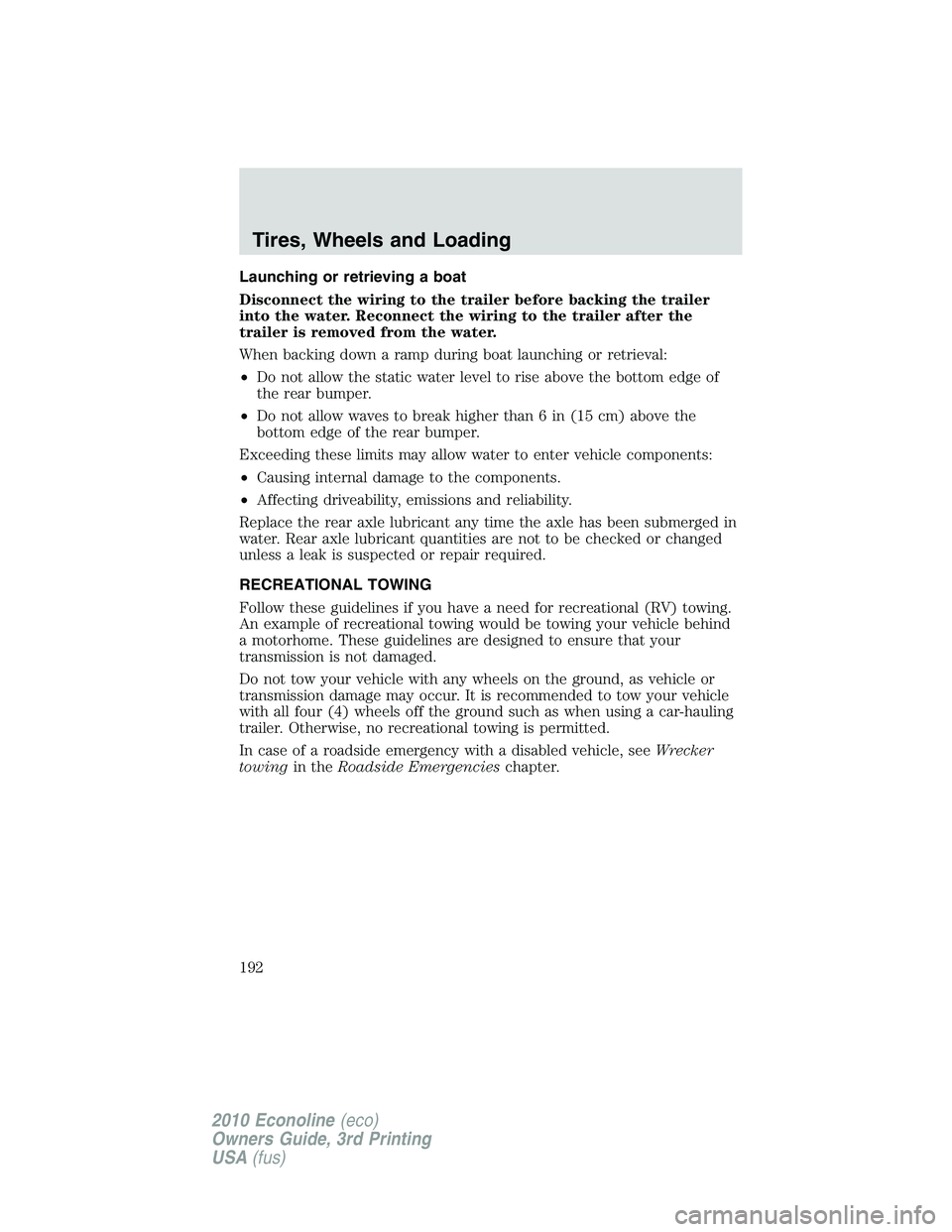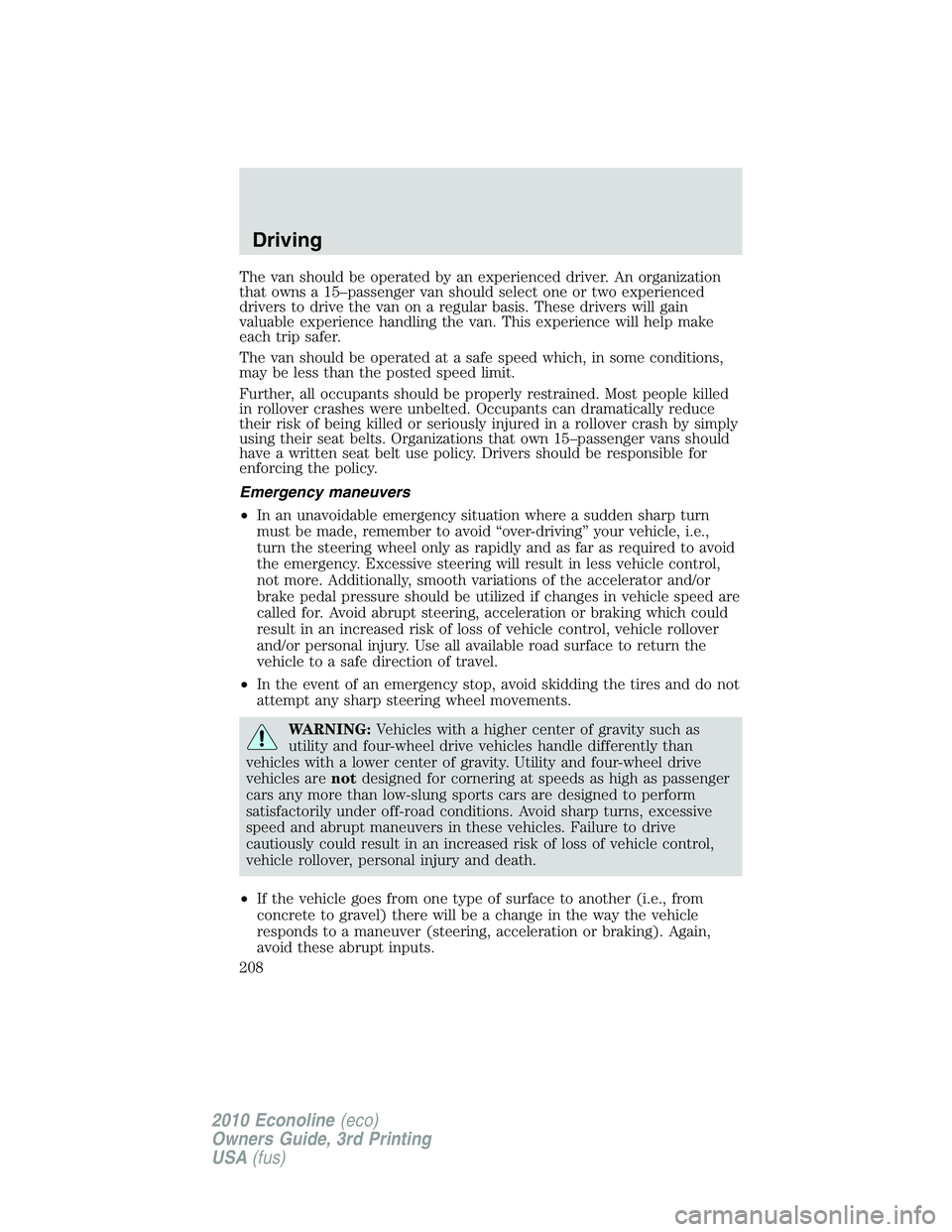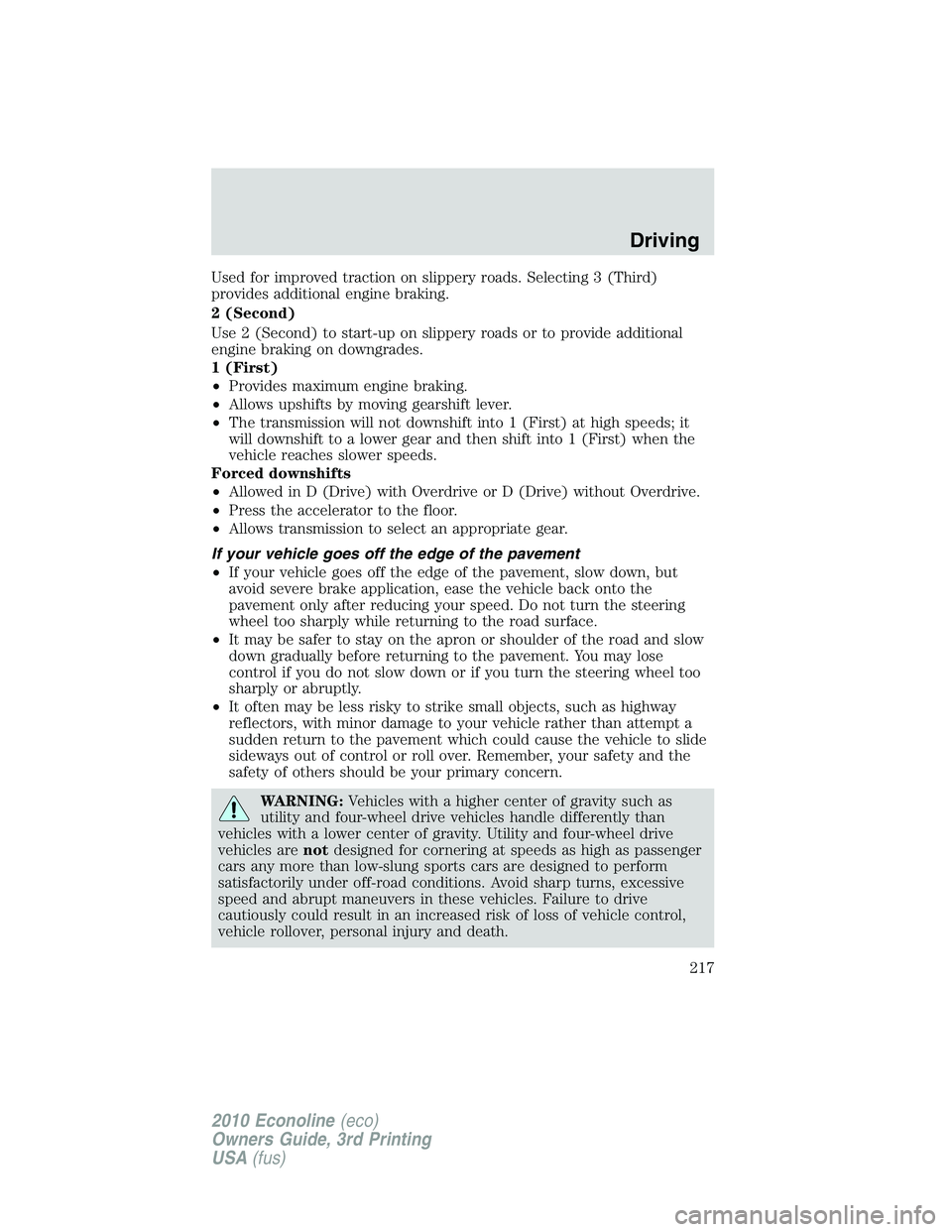2010 FORD E450 four wheel drive
[x] Cancel search: four wheel drivePage 192 of 327

Launching or retrieving a boat
Disconnect the wiring to the trailer before backing the trailer
into the water. Reconnect the wiring to the trailer after the
trailer is removed from the water.
When backing down a ramp during boat launching or retrieval:
•Do not allow the static water level to rise above the bottom edge of
the rear bumper.
•Do not allow waves to break higher than 6 in (15 cm) above the
bottom edge of the rear bumper.
Exceeding these limits may allow water to enter vehicle components:
•Causing internal damage to the components.
•Affecting driveability, emissions and reliability.
Replace the rear axle lubricant any time the axle has been submerged in
water. Rear axle lubricant quantities are not to be checked or changed
unless a leak is suspected or repair required.
RECREATIONAL TOWING
Follow these guidelines if you have a need for recreational (RV) towing.
An example of recreational towing would be towing your vehicle behind
a motorhome. These guidelines are designed to ensure that your
transmission is not damaged.
Do not tow your vehicle with any wheels on the ground, as vehicle or
transmission damage may occur. It is recommended to tow your vehicle
with all four (4) wheels off the ground such as when using a car-hauling
trailer. Otherwise, no recreational towing is permitted.
In case of a roadside emergency with a disabled vehicle, seeWrecker
towingin theRoadside Emergencieschapter.
Tires, Wheels and Loading
192
2010 Econoline(eco)
Owners Guide, 3rd Printing
USA(fus)
Page 208 of 327

The van should be operated by an experienced driver. An organization
that owns a 15–passenger van should select one or two experienced
drivers to drive the van on a regular basis. These drivers will gain
valuable experience handling the van. This experience will help make
each trip safer.
The van should be operated at a safe speed which, in some conditions,
may be less than the posted speed limit.
Further, all occupants should be properly restrained. Most people killed
in rollover crashes were unbelted. Occupants can dramatically reduce
their risk of being killed or seriously injured in a rollover crash by simply
using their seat belts. Organizations that own 15–passenger vans should
have a written seat belt use policy. Drivers should be responsible for
enforcing the policy.
Emergency maneuvers
•In an unavoidable emergency situation where a sudden sharp turn
must be made, remember to avoid “over-driving” your vehicle, i.e.,
turn the steering wheel only as rapidly and as far as required to avoid
the emergency. Excessive steering will result in less vehicle control,
not more. Additionally, smooth variations of the accelerator and/or
brake pedal pressure should be utilized if changes in vehicle speed are
called for. Avoid abrupt steering, acceleration or braking which could
result in an increased risk of loss of vehicle control, vehicle rollover
and/or personal injury. Use all available road surface to return the
vehicle to a safe direction of travel.
•In the event of an emergency stop, avoid skidding the tires and do not
attempt any sharp steering wheel movements.
WARNING:Vehicles with a higher center of gravity such as
utility and four-wheel drive vehicles handle differently than
vehicles with a lower center of gravity. Utility and four-wheel drive
vehicles arenotdesigned for cornering at speeds as high as passenger
cars any more than low-slung sports cars are designed to perform
satisfactorily under off-road conditions. Avoid sharp turns, excessive
speed and abrupt maneuvers in these vehicles. Failure to drive
cautiously could result in an increased risk of loss of vehicle control,
vehicle rollover, personal injury and death.
•If the vehicle goes from one type of surface to another (i.e., from
concrete to gravel) there will be a change in the way the vehicle
responds to a maneuver (steering, acceleration or braking). Again,
avoid these abrupt inputs.
Driving
208
2010 Econoline(eco)
Owners Guide, 3rd Printing
USA(fus)
Page 217 of 327

Used for improved traction on slippery roads. Selecting 3 (Third)
provides additional engine braking.
2 (Second)
Use 2 (Second) to start-up on slippery roads or to provide additional
engine braking on downgrades.
1 (First)
•Provides maximum engine braking.
•Allows upshifts by moving gearshift lever.
•The transmission will not downshift into 1 (First) at high speeds; it
will downshift to a lower gear and then shift into 1 (First) when the
vehicle reaches slower speeds.
Forced downshifts
•Allowed in D (Drive) with Overdrive or D (Drive) without Overdrive.
•Press the accelerator to the floor.
•Allows transmission to select an appropriate gear.
If your vehicle goes off the edge of the pavement
•If your vehicle goes off the edge of the pavement, slow down, but
avoid severe brake application, ease the vehicle back onto the
pavement only after reducing your speed. Do not turn the steering
wheel too sharply while returning to the road surface.
•It may be safer to stay on the apron or shoulder of the road and slow
down gradually before returning to the pavement. You may lose
control if you do not slow down or if you turn the steering wheel too
sharply or abruptly.
•It often may be less risky to strike small objects, such as highway
reflectors, with minor damage to your vehicle rather than attempt a
sudden return to the pavement which could cause the vehicle to slide
sideways out of control or roll over. Remember, your safety and the
safety of others should be your primary concern.
WARNING:Vehicles with a higher center of gravity such as
utility and four-wheel drive vehicles handle differently than
vehicles with a lower center of gravity. Utility and four-wheel drive
vehicles arenotdesigned for cornering at speeds as high as passenger
cars any more than low-slung sports cars are designed to perform
satisfactorily under off-road conditions. Avoid sharp turns, excessive
speed and abrupt maneuvers in these vehicles. Failure to drive
cautiously could result in an increased risk of loss of vehicle control,
vehicle rollover, personal injury and death.
Driving
217
2010 Econoline(eco)
Owners Guide, 3rd Printing
USA(fus)
Page 324 of 327

Event data recording ....................8
Exhaust fumes ..........................196
F
Fail safe cooling ........................284
Flexible Fuel Vehicle (FFV) ....286
Fluid capacities .........................309
Four-Wheel Drive vehicles
preparing to drive your
vehicle .....................................207
Fuel ............................................286
calculating fuel
economy ............................22, 293
cap ...........................................289
capacity ...................................309
choosing the right fuel ...........290
comparisons with EPA fuel
economy estimates .................296
detergent in fuel .....................291
filling your vehicle with
fuel ...........................286, 289, 293
filter, specifications ........286, 308
fuel pump shut-off switch .....227
improving fuel economy ........293
octane rating ...................291, 313
quality ......................................291
running out of fuel .................292
safety information relating to
automotive fuels .....................286
Fuel - flex fuel vehicle
(FFV) .........................286, 290–291
Fuses ..................................229–230
G
Gas cap (see Fuel cap) ............289
Gas mileage
(see Fuel economy) .................293
Gauges .........................................19H
Hazard flashers .........................226
Head restraints ...........................85
Headlamps ...................................50
aiming ........................................53
bulb specifications ....................56
daytime running lights .............50
flash to pass ..............................51
high beam .................................50
replacing bulbs .........................57
turning on and off ....................50
Heating
heater only system .............47, 49
heating and air conditioning
system .......................................48
Hood ..........................................271
I
Ignition ...............................193, 313
Illuminated visor mirror .............63
Infant seats
(see Safety seats) .....................117
Inspection/maintenance (I/M)
testing ........................................298
Instrument panel
cleaning ...................................267
cluster ........................................14
lighting up panel and
interior .......................................51
J
Jack ............................................237
positioning ...............................237
storage .....................................237
Jump-starting your vehicle ......247
Index
324
2010 Econoline(eco)
Owners Guide, 3rd Printing
USA(fus)